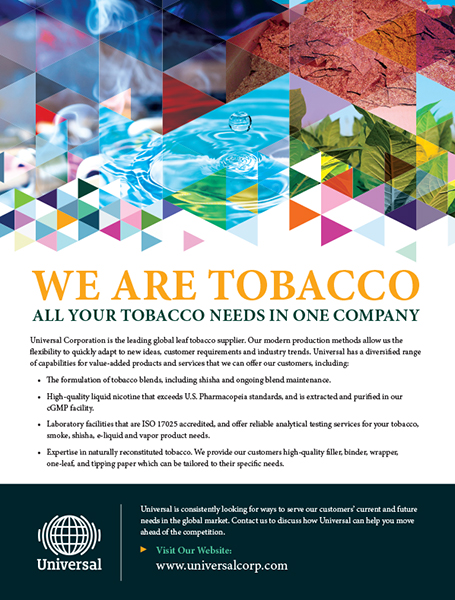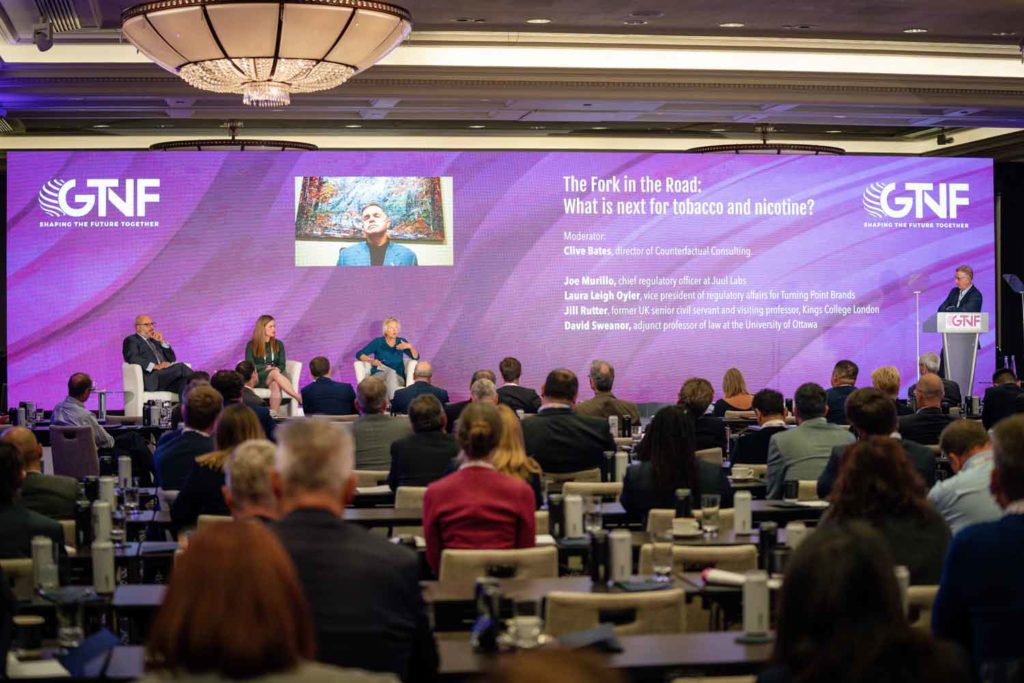The Fork in the Road
- Also in TR GTNF Print Edition
- November 1, 2021
- 0
- 2
- 34 minutes read


Following the virtual conference in 2020, which had been forced online by the coronavirus pandemic, the GTNF was pleased to once again welcome delegates in person in 2021. The Rosewood Hotel in London hosted 162 delegates Sept. 21–23, with an additional 720 participants following the speeches and discussion panels online.
The event attracted both industry representatives and stakeholders from other sectors, including government, civil society and the legal profession. In addition, GTNF 2021 generated considerable interest among the media, with representation from prominent outlets such as The Wall Street Journal, Bloomberg and Le Monde.
Below is a sampling of the 2021 GTNF keynotes and panel discussions. For additional coverage of the event, please click here.
To read what delegates had to say about the ninth Conference of the
Parties to the Framework Convention on Tobacco Control that is scheduled
to take place this month, please click here.

Matt Ridley: The importance of innovation
Matt Ridley, who is a member of the U.K. Parliament’s upper house, ended his presentation by saying the All-Party Parliamentary Group for Vaping, of which he is a member, had recently urged the U.K. government to attend this year’s Conference of the Parties to the World Health Organization’s Framework Convention on Tobacco Control and, while there, use its relatively independent post-Brexit voice to argue strongly against the e-cigarette prohibitionists and in favor of scientific evidence and the harm reduction argument. “I don’t know whether we will be listened to by the U.K. government on this, but we are going to try and get this point across because I think it’s … it’s a moral one, and I think we have a duty to try to win the point,” he said.
This will have gone down well with many of the conference participants, who will have agreed with Ridley’s earlier comment that the WHO’s war on vaping was “positively unhinged” and flew in the face of evidence that it reduced smoking. And here he illustrated his point by quoting Chris Snowden of the Institute of Economic Affairs as saying the WHO had doubled down on its hostility to vaping even as real-world evidence continued to show smoking rates declining as vaping rates increased.
Ridley’s was the first keynote presentation of the event, and, while it did not contain much else that was new, it ran through most of the underlying issues causing concern to the vaping industry, and it did so with panache. He covered, among other subjects, the assessment of relative risk and its relationship with the concept of harm reduction, innovation and the main ideas that motivated some people, including some public health professionals and politicians, to want to ban the technology underpinning vaping.
The first motivation, he said, was down to the inappropriate application of the precautionary principle in answer to the question, “What if this technology turns out to have unknown risks?” While that question was valid, he added, in the case of vaping, the answer was that it would be better to take the small risk that there were unknown hazards than the known risks that there were large hazards. The second motivation was a general hatred of all things related to nicotine, which was deeply ingrained in the culture and underlined by the involvement of tobacco companies in the vaping industry.
The third motivation was self-interest. The pharmaceutical industry had a nice little earner called nicotine-replacement therapy, and since its patches and gums didn’t work very well, the market for them remained limitless. And the fourth motivation was simply down to the urge to ban. Some people loved to disapprove, and they were able to come up with all sorts of specious arguments about why they disliked e-cigarettes and why, therefore, they should be banned.
Ridley, an author whose books have sold more than a million copies and been translated into 31 languages, added to his output in 2020 with the publication of How Innovation Works, and part of his presentation looked at the way in which innovative products often initially meet with considerable opposition. Margarine, he said, had been opposed by dairy producers, refrigerators by natural ice suppliers, tractors by the people who went under the name of the Horse Association, umbrellas by hansom cab drivers, coffee by vintners and the telephone by what sounded like an old curmudgeon worried that this then-new contraption would destroy private life if it were not restricted. (Of course, with most of us now suffering daily from the debilitating effects of vacuous, secondhand mobile conversations, it might be worthwhile revisiting the old curmudgeon’s complaint.)
The audience, I think, will have been struck by two things in relation to these examples. One, obviously, is that they are all from the distant past. The other is that whereas nearly all of them involve people trying to protect their self-interests, those self-interests comprised their livelihoods and none of their actions threatened to cause direct harm to others. So while the opposition to these products and services can be likened to the opposition to vaping, there is an important difference because unjustified opposition to vaping does directly threaten the well-being of others: current smokers.
Given that this session report starts with Ridley’s last words, it might be appropriate if it ends with his first words: a gentle plug for his latest book. It had been co-authored by a brilliant molecular biologist at Harvard, Alina Chan, he said, and it was called Viral: The Search for the Origin of Covid-19. “You can buy it in all good bookstores from the middle of November,” he added helpfully.


Stefan Bomhard: Putting the consumer first
Across all industries, the Covid-19 pandemic has been one disruptive force, which drove government intervention, accelerated consumer trends and, as a result, spurred further innovation. The tobacco and nicotine industry, which finds itself in a period of rapid change, has been no exception: Controversial policy led to bans on combustible cigarettes as seen in South Africa, but at the same time, growing health consciousness has led to an increased interest in reduced-risk alternatives.
Stefan Bomhard, who previously worked in the alcohol industry and joined Imperial Brands as CEO in July 2020 from Inchcape, a global distribution and retail leader in the premium and luxury automotive sectors, shared his views on the longer term transformation of the tobacco and nicotine industry, looking at how stakeholders could collectively be best at making a reality of a healthier future. He observed parallels between the vaping sector and the automotive industry, where manufacturing for many years had been seeking to improve the efficiency of the 160-year-old technology of the combustible engine. “Then climate change became the climate crisis, and the e-engine meant a complete turnaround,” he said.
Innovation, Bomhard emphasized, can happen only if supported by private sector efforts. As regulation of reduced-risk products (RRPs) edges toward prohibition, unintended consequences such as illicit trade arise. “The industry has to step up and present continuously better choices for consumers,” Bomhard said. “Smokers need to be perceived as informed people who want to make informed choices. There is no single route to tobacco harm reduction, but a billion individual paths.”
Imperial Brands, which in the past 25 years developed from a domestic player into an international player, sees its role in this development in delivering a better experience for consumers. “From my experience, small players can flourish with the right mindset,” he said.
While keen to transform the tobacco industry, Bomhard insisted Imperial Brands remains 100 percent committed to combustible cigarettes. “They are the core business for building a harm-reduced company, as they finance the investments in tobacco harm reduction,” he noted.
To transform Imperial Brands, he explained, additional capacities have been built, including increased research of consumers’ needs. The company hired its first consumer product officer earlier this year. Products will be improved based on the findings of consumer studies. At this point in time, consumers have chosen heated-tobacco products over vaping, according to Bomhard, so Imperial Brands focuses on offering products in that segment.
Furthermore, a number of new executives have joined Imperial Brands, bringing in new capabilities and contributing to the development of a new, more innovation-headed mindset in the organization. The focus is on the question of how employees can play a practical role in driving innovation, Bomhard pointed out.
In addition to harm reduction, he went on, the industry had other important challenges, inclusive of supporting better lives for farming communities, transitioning to a lower carbon business model and reducing waste. “The future of the industry will without doubt have twists and turns,” he said. “For me, having enjoyed a career in a variety of fast-moving industries, each one of them facing major structural changes, the year with Imperial has enforced my first impression that right now, there is no more dynamic sector than tobacco and nicotine.”


Panel: What is Next for Tobacco and Nicotine
The vaping industry faces many challenges. The road to a viable future for these products must pass through sensible regulations based on science. In the current environment, unfortunately, this will be challenging, according to speakers on the GTNF plenary panel The Fork in the Road: What is Next for Tobacco and Nicotine. Misperceptions surrounding nicotine and vaping products, the panelists agreed, are furthered by the mass media’s “wonton disregard” for the science behind the tobacco harm reduction potential of electronic nicotine-delivery systems (ENDS).
One speaker noted that in addition to many countries banning or erecting insurmountable barriers to vaping products, well-funded anti-nicotine activists are attacking the people who are bringing reduced-risk products to adult combustible cigarette smokers trying to quit smoking. These groups are opposed to the tobacco harm reduction that science and innovation can bring.
All of these activities together only serve to enhance the vaping industry’s problem: the massive public misperception that vaping is as deadly as smoking cigarettes. The fact that a significant number of physicians mistakenly belief that nicotine, rather than combustion, is responsible for smoking-related illness, bodes ill for the perceptions among the general population. “If physicians believe this, imagine the views of the average smoker in Kenya or Chicago, Illinois, or in Australia,” one speaker said.
While anti-nicotine activists have done their share to misperceptions, the vaping industry too is partly to blame, according to one panelist. The ENDS industry can do a lot more than feel helpless or complain, this speaker noted. Innovation in harm reduction cannot occur without the vaping industry’s support. That means responsible marketing, combating illicit trade, limiting youth access and making sure that the ENDS industry is doing what it can to prevent underage use.
Panelists also expressed concern about the direction of the vapor market in the wake of the U.S. Food and Drug Administration’s marketing denial orders (MDOs), with some describing a “Wild West” scenario. After receiving MDOs, some companies have turned to synthetic nicotine because that product currently is outside of the agency’s jurisdiction. A panelist said that the FDA’s “scorched earth” approach to flavored products is only creating bigger problems in the market, adding that if a market isn’t regulated, there is still going to be an unregulated illicit market that has the potential to be more deadly than that for combustible tobacco.
“Nobody wants kids to take up the products … it’s a very significant responsibility that we in industry be there to be the stewards of that concept in generating science and evidence,” a panelist said. “We should all be proud of the good science that is being generated … that is our responsibility: to generate and publish and participate in the scientific debate and pursue reasonable regulation. What is reasonable? I don’t know. It’s not going to be nothing. We all have to get over it and figure out what is the right way forward so we can go back to helping the consumer and making sure we’re only serving smokers who are looking for alternatives to combustibles.”


Amanda Wheeler: Continuing the fight
Amanda Wheeler got involved in the vapor business after a personal tragedy. Despite a cancer diagnosis, she was unable to quit smoking for years—until she discovered vapor products. Eager to share her success with others, Wheeler and her husband, Jourdan, opened JVapes, an e-liquid manufacturer and retail store in Prescott, Arizona, USA, in 2012.
The business was successful, quickly expanding to multiple locations across three states. Wheeler was helping her customers quit smoking combustibles and became increasingly involved in advocacy.
In October of 2020, Wheeler and fellow business owner Char Owen created the American Vapor Manufacturers Association (AVM) to help small businesses navigate the U.S. Food and Drug Administration’s onerous premarket tobacco product application (PMTA) submission process. The organization also engaged in federal lobbying and sought to provide reduced-cost scientific testing and expert regulatory compliance advice to members preparing PMTAs.
The deadline for submitting PMTAs to the FDA was Sept. 9, 2020. Wheeler submitted timely applications and was allowed to keep her products on the market for up to one year while the FDA reviewed her submissions. But on Sept. 9, 2021, Wheeler received a marketing denial order (MDO). The regulatory agency appeared determined to put the company she and her husband had built, along with the industry she passionately defended, out of business.
That day, the FDA issued MDOs to more than 130 companies, requiring them to pull an estimated 946,000 products from the market. The bloodbath continued in the following weeks. At press time, the FDA had issued 323 MDOs accounting for more than 1,167,000 flavored electronic nicotine-delivery systems (ENDS). As of Sept. 28, not a single ENDS had been approved.
“[The] FDA knew that they didn’t have the time or the resources to give our products fair consideration, but instead of asking for help, they let the 9/9 deadline pass and left the more than 500 companies subject to their decision in an unstable and probably untenable position,” Wheeler explained. “The FDA’s arbitrary ruling effectively criminalizes thousands of long-standing businesses in communities all across the country. Those entrepreneurs now have to junk their inventory, fire their employees, stiff their investors, and defer their dreams.”
Wheeler said she was standing up for the “little guy”—the thousands of small business owners who manufacture, distribute and retail open system products in vape shops all over the United States. She explained that her business and other AVM members made every attempt within their means to comply with the FDA regulations. It was an expensive process. It was also a system designed for small businesses to fail from the very beginning, she said.
“My company personally submitted several hundred thousand pages of documents to the FDA in an attempt to comply with this one premarket tobacco application standard. The [FDA’s] decision doesn’t just make a mockery of that earnest work. It also makes the more than 10 million Americans who made the switch to vapor products—in our vape shops, with our liquids—into outlaws, too,” said Wheeler.
Wheeler said the FDA, in an act of “regulatory arson,” was creating a tobacco-led monopoly over the vaping industry, as only the companies with the deepest pockets stand a chance to survive the agency’s cumbersome PMTA process.
She also focused on what she perceived to be one of the biggest challenges facing the industry today: misinformation. “There is one other group I want to address with my time here. It’s the activists and the press who—whether because they are misguided or malicious—spread the falsehoods and distortions that directly led to this tragic outcome,” she said.
The biggest victims of the FDA’s actions, according to Wheeler, are the vapers who will now struggle to acquire the products that have helped them stay off of cigarettes. Wheeler vowed she would continue to fight for her customers and fellow business owners. “Even through their dismay, I am hearing a constant refrain: We are not going to stand for it,” she noted.
“We will be at the FDA’s doorstep demanding answers or forcing them through Freedom of Information Act laws and the courts. We are not surrendering our business or abandoning vapers to cigarettes,” she said. “As we say in Arizona, this is more than just a fight. It’s going to be a reckoning.”

Joe Murillo and Todd Cecil: The regulator’s view
When the U.S. Food and Drug Administration began issuing marketing denial orders (MDOs) for vapor products, the industry was understandably shocked. Many companies that had submitted timely premarket tobacco product applications by Sept. 9, 2020, had expected to first receive a deficiency letter and not immediately an order to remove their products from the market. Some MDO recipients complained the agency had “moved the goalposts” by suddenly requiring studies that it had previously said were not required.
At least three companies have filed lawsuits over their MDOs. All are accusing the agency of making “arbitrary” decisions and not reviewing the submitted data according to the statutes. In a “fireside chat” between Joe Murillo, chief regulatory officer for Juul Labs, and Todd Cecil, deputy director of the Office of Science for the FDA’s Center for Tobacco Products, during the recent GTNF in London, Cecil acknowledged the missing data that caused the flurry of MDOs is not required by the statutes that regulate tobacco products.
When asked what the “level of expectation” the FDA had in deciding whether to issue a deficiency letter or an MDO after a premarket tobacco product application (PMTA) was moved into scientific review, Cecil said that the agency followed “a randomized approach” to choose the applications the FDA would work on.
“The randomized approach identified a number of manufacturers’ products that went into this scientific review, and we … evaluated them from top to bottom,” he said. Cecil noted the agency began to see in some applications that “tended to have problems or missing materials that we needed in terms of benefits [of flavors]; that we learned we have to have that benefit piece … that evaluation that we spent several months working on taught us what we had to look for to be able to [conduct] a full scientific review.”
Cecil said that the agency just figured “if we know going right in that there are pieces missing, why will they go through a deficiency process and with a very short turnaround expecting to get back a full study that wasn’t completed previously?” So, instead of issuing a deficiency letter as required by statute, the FDA just handed out MDOs because the agency knew that it would take a company a significant amount of time and expense to conduct the new required longitudinal and cohort studies. Cecil was then asked why the agency filed the applications in the first place.
“We had to make a determinant how can we streamline this evaluation and determine those products that have at least the bare minimum for us to do a real and complete evaluation,” Cecil said. “This evaluation is not a standard. It is not a de facto standard or anything else. This is information that we need to see, but it’s not a requirement. An RTF [refuse to file] are those things that are required by the statute. And these studies are not necessarily required by the statute.”
The FDA has also been facing an unprecedented amount of scrutiny on how its handling of regulation of electronic nicotine-delivery system (ENDS) products and the PMTA process. Numerous health groups, anti-nicotine groups, states attorneys general and even members of Congress have criticized the FDA and demanded action. When asked if the FDA’s actions were influenced by these groups, Cecil said the agency focuses on science.
“We’re science-based,” he said. “We need look at what is presented to us in the application and in the laboratory. That is what we’re most focused on. If there is new data out there and that new data is brought to our attention through one of these [groups], then that’s fine. We would be happy to get those up and understand the bigger picture, all of the data … We need to evaluate those as scientifically or make a determination based upon that science.”
Only 100,000–200,000 products remain under FDA review. Of the 6.7 million submitted PMTAs, all others have received either a refuse-to-accept, an RTF or an MDO response. Cecil denied the agency was making a “categorical policy decision as opposed to an application-by-application decision” about flavored products. “We are stating that we understand that there is a significant youth initiation risk that comes from flavored ENDS products,” he said. “We are, in fact, reviewing all of those, and what we have found as we’ve done our reviews is that none of the literature is sufficient to demonstrate that there is not a youth initiation risk for individual flavors.
“We see that tobacco has a lower initiation risk. We see that menthol has some issues with it, and we are going to be evaluating that as we go forward. However, all of the data points to the flavored products as having significant youth initiation concerns. So what we’re looking for is an adequate indication that there’s a benefit on the other side of the equation. This is not a decision that we aren’t going to accept flavored products. Absolutely opposite. We need to ensure that there is concrete and robust data that demonstrates that there is an existing user benefit for those products.”
Cecil declined to say when more MDOs would be issued or when the agency would rule on major products, such as Juul, NJOY, blu and Vuse. “We continue to work diligently,” is all he would say. “There are a number of products that are well along. But no, I can’t tell you how many are those ones, but there are some that we’re hoping to move forward in the short term.”
The FDA’s recent action against flavored e-liquids does not mean that the FDA will never approve a flavored e-liquid, according to Cecil. He said that the rejected applications just lacked the required information that those products met the agency’s “appropriate for the protection of public health” standard. “You are welcome to reapply once you have addressed the issues that we provided to you,” he said. “And we will reevaluate that at a future date.”

Investment Panel: A New Case for Tobacco
Despite the rough ride for tobacco stocks in recent years, the investment case for tobacco and nicotine remains strong, according to the participants in the Global Tobacco and Nicotine Forum (GTNF) 2021 investors panel. Under the direction of Eric Bloomquist, four prominent tobacco analysts—Jonathan Fell of Ash Park Capital, Rupert Wilson of Strategic Business Consulting, Pieter Vorster of Idwala Research and Gaurav Jain of Barclays—debated the outlook for tobacco in a rapidly changing business environment. Even as the industry suffered from Covid-19-related fallout, its legendary pricing power remained intact and continued to deliver profit growth and cash flow. With supply chain disruptions affecting many sectors, tobacco has even become a safe hiding place again, one panelist ventured.
That said, some companies have clearly done better than others. Those with greater exposure to noncombustible products are attracting higher valuations than those with a lower portion of their revenues coming from that business, and the panelists debated whether that discrepancy would prompt investors to pressure the underperformers to “get their act together.” Not everybody was convinced. As one participant pointed out, shifting the world’s 1.1 billion smokers to noncombustibles is a very long-term project. “Realistically, there is time for the companies who don’t have the right strategy to eventually get there,” he said. A word of caution was also uttered against compromising the cash flow machines: The transition to less risky nicotine products requires lots of investment, and many of those funds are still generated by sales of traditional cigarettes.
Speculating on possible mergers and acquisitions, the panelists considered a reunification of Altria Group and Philip Morris International unlikely in the near future. As one participant pointed out, PMI has publicly committed to deriving more than 50 percent of its net revenues from smoke-free products by 2025. Because Altria currently receives a smaller share of its earnings from such offerings than does PMI, it would be harder for the combined entity to meet PMI’s target. What’s more, many PMI investors like the fact that they can currently choose whether or not they want exposure to the uncertain U.S. market—an option that would no longer be available after any merger.
One panelist suggested Swedish Match as an acquisition target for PMI. After the recently announced separation of its cigar business, Swedish Match would offer PMI attractive complementary smokeless businesses, such as snus and modern oral, the panelist said. Others contemplated the possibility of spinoffs by Imperial Tobacco, which has announced greater focus on its core markets. The problem here, noted one panelist, would be the buyer: With all large tobacco companies keen to reduce their dependence on combustibles, there is no obvious taker for such a business—at least not among the publicly listed firms. This, in turn, led to speculation about the designs of China’s State Tobacco Monopoly, which is not accountable to shareholders—but the panelists quickly agreed it was futile to figure out “what is happening in China.”
The discussion then turned to the impact of environmental, social and governance (ESG) initiatives on investors. Would tobacco companies’ efforts to transition smokers away from deadly combustibles prompt investors who might otherwise have shunned the sector to take another look? Panelists agreed that the Foundation for a Smoke-free World’s Tobacco Transformation Index, which evaluates tobacco manufacturers on efforts and actions relating to tobacco harm reduction, could prove to be a valuable tool for investors. Companies that are doing the most in this area are already enjoying the best valuations, one panelist pointed out. They also pointed to the entrance into the market of new nicotine companies that offer no combustibles, such as RELX and SMOORE, which have broadened the options. PMI’s recent acquisitions of pharmaceutical companies, such as Vectura, could also generate interest from a new class of investors, the analysts ventured.
At the same time, the panelists acknowledged the challenges facing tobacco companies in escaping the tobacco “taint.” Many financial websites offer investors a dropdown menu with the option to exclude “tobacco”—a broad label that includes both companies wedded to traditional cigarettes and firms at the forefront of transitioning smokers away from such products.
One panelist detected a marketing opportunity. Its premise would be simple: Rather than pretending tobacco companies don’t exist, such a fund could offer to invest in their depressed stocks and help them change. “That would be a useful approach for the world and an interesting proposition for investors,” he said.

Open Mic: Tackling the Hard Questions
One of the panelists at the final session of the Global Tobacco and Nicotine Forum (GTNF) 2021, the Open Mic, indicated that he and his colleagues were spending a lot of time trying to validate innovative ways of substantiating tobacco harm reduction. He was responding to a question about whether breaking through to those so far unconvinced about the harm reduction credentials of new-generation tobacco/nicotine products would require more research or whether a different approach was needed. It was obvious that regulators would want to see the results of high-quality studies, he said, but what was not so obvious was what kinds of studies were needed. It was known, however, that if somebody stopped smoking tobacco, they benefited from a whole world of physical improvements that could be measured; the problem was how to measure those changes effectively and in a timely manner.
The Open Mic session lasted one-and-a-half hours and provided event participants with the opportunity to ask some challenging questions, one of which touched on the fact that in some tobacco markets, up to 35 percent of smokers are occasional or nondaily smokers, most of whom don’t use other nicotine products on days when they don’t smoke. Given this, what was the role of nicotine in moving people away from combustible products?
One response suggested that the issue of addiction or dependence was oversimplified, as though all smokers were the same and all were addicted, an idea that was not entirely true. There had been overexposure of the problem of addiction and dependence, especially in relation to young people, when, in fact, some people were able overnight and without withdrawal symptoms to quit a smoking habit that had lasted up to 40 years. It was time for the book of addiction and dependence to be rewritten.
Another panelist took the view that the issue of the spectrum that took in addiction, dependence and pleasure was complex, and focusing on it as if it were the main moral question that had to be grappled with was not helpful. Having such a focus was to miss the target. The target should be to reduce risk and to reduce disease. In fact, the important moral question was do physicians and members of the scientific medical community give smokers an additional option or not? Do they provide them with proper guidance on how to quit but give them the right to choose, or do they condone only the methods of which they approve?
Broadly speaking, the Open Mic session included three panelists from the world of science and healthcare and three from the world of business, one of whom appeared remotely from China. The session started, however, with a comment from one of its two moderators, who said the 2021 GTNF was the first conference she had been at where the consumer was front and center. But there was a sting in the tail. Some consumers, she added, those who still used traditional tobacco products, were not at the center except in the sense that they were the subject of discussions on how to get them to move to one of the many new-generation products coming onto the market. In a way, the suggestion seemed to be: Where was the “T” in GTNF?
A corollary to this question came up later when it was asked whether committed traditional tobacco users should be continually bombarded with information by those wanting them to quit or switch to less risky products or whether, at some point, it should be accepted that since they were determined to continue with their habit, they should be left alone to enjoy it. Nobody got to grips with this question, perhaps because it was too raw or because this “hard core” of smokers would make up the 5 percent who would still exist in countries that had “eliminated” smoking. Although one panelist made the point that in a relatively free world, people should be allowed to do what they wanted to do with a legal product, most merely suggested that new-generation products and the messages around them should be improved, presumably until even the hard core of smokers came on board.
There is clearly a problem with such communications, however. One simple but insightful question asked where a smoker looking to quit should go for advice. This presents a conundrum because the tobacco/nicotine and pharmaceutical industries have financial interests in the outcome, many healthcare professionals are ill-informed and social media is crawling with conspiracy theories. One panelist made the point that it could turn out that your friend who had already benefited from switching from consuming traditional tobacco products to using new-generation products could prove to be the most important medical adviser you would ever consult.
